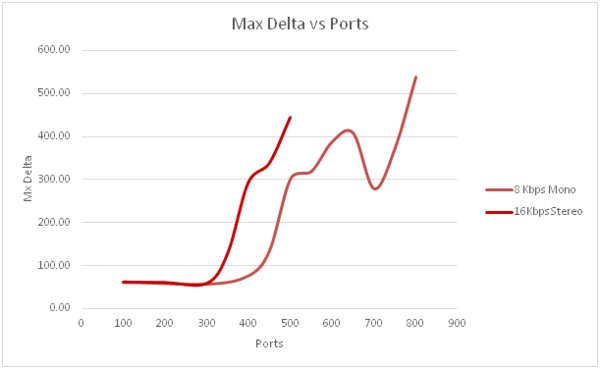Multiple Dispatcher Tests
The GVP 8.5.1 August 2015 release added support for multiple dispatchers and improved latency performance on physical servers. Capacity increased due to the latencies improvements; CPU usage can now be increased as well.
Below are results from three tests from configurations of one dispatcher, four dispatchers, and eight dispatchers on a single 8-core physical server using SW Profile 1a (16Kbps MP3 stereo only without encryption).
Results from four-dispatcher and eight-dispatcher configurations show significant improvement, when compared against the default of one dispatcher. Additionally, the results with eight dispatchers show slightly better results than with four dispatchers.
The next results are for system CPU usage:
CPU usage for one dispatcher is slightly higher than four and eight dispatchers, while CPU usage flattens out near peak capacity. The four-dispatcher and eight-dispatcher configurations may drive the CPU slightly higher, and thus achieve the higher capacity.
The next results are for memory usage:
Memory usage for four-dispatcher and eight-dispatcher configurations is similar, with eight dispatchers using slightly less memory. Genesys recommends the eight-dispatcher configuration. Comparing eight dispatchers to the default one dispatcher reveals a 36% increase in preferred capacity (300 vs 220 ports); eight dispatchers achieved a 50% increase in peak capacity.
Jitter and Delta Tests
The results below were achieved using the same four-dispatcher and eight-dispatcher configurations, on a Windows 2008 R2 server with the same hardware specifications as the previous tests.

These results are the same as were seen on similar Linux systems—eight-dispatcher configurations achieved slightly better results than four-dispatcher configurations. Genesys recommends that the number of dispatchers and the number of cores should be the same in physical server configurations.
MP3 8 Kbps Mono Support
Physical Server Windows 2008 R2
The GVP 8.5.1 August 2015 release added support for MP3 Mono with an 8Kbps bit rate. Genesys tested the recommended eight dispatchers configurations on physical servers running Windows 2008 R2 Server and Linux EL 6.6, to compare with the results for 16Kbps MP3 stereo configurations.
Below are graphs of Max Jitter and Max Delta for latencies on a Windows 2008 R2 Server:
Below are CPU and Memory usage results for a Windows 2008 R2 Server configuration:
The above results show that an 8 Kbps configuration uses less CPU and memory, with lower latencies of observed for Max Jitter and Max Delta, which achieves higher capacity. For example, there was a 28.6% increase in capacity (450 vs 350 ports) for preferred ports, and a 33.3% increase in peak capacity (600 vs 450 ports) when using 8 Kbps Mono compared to 16Kbps Stereo.
| Ports | Physical Server Disk IOPS | ||
| Total | Reads | Writes | |
| 100 | 60.35 | 0.00 | 60.35 |
| 300 | 168.82 | 0.00 | 168.82 |
| 400 | 224.52 | 0.00 | 224.52 |
| 450 | 252.20 | 0.00 | 252.20 |
| 500 | 280.28 | 0.00 | 280.28 |
| 550 | 306.22 | 0.00 | 306.22 |
| 600 | 333.88 | 0.00 | 333.88 |
| 650 | 359.84 | 0.00 | 359.84 |
| 700 | 388.11 | 0.00 | 388.11 |
| 750 | 415.87 | 0.00 | 415.87 |
| 800 | 441.96 | 0.00 | 441.96 |
Physical Server Linux EL 6.6 Tests
These tests were performed on a Linux EL 6.6 physical server. The graphs below compare Max Jitter and Max Delta for latencies with an MP3 8Kbps bit rate Mono configuration with using a 16 Kbps MP3 stereo configuration.
Overall system CPU usage is shown below:
The same trend was seen on Linux as was seen on Windows—slightly lower CPU usage for 8 Kbps Mono, lower latencies for both Max Jitter and Max Delta, thereby achieving higher capacity.
In fact, there is a 100% increase in preferred ports capacity (600 vs 300 ports), and an 80% increase in peak capacity (650 vs 360 ports) when using 8 Kbps Mono on Linux (with no encryption).
| Ports | Physical Server Disk IOPS | ||
| Total | Reads | Writes | |
| 100 | 49.95 | 0.00 | 49.95 |
| 300 | 138.42 | 0.00 | 138.42 |
| 350 | 157.07 | 0.00 | 157.07 |
| 400 | 178.74 | 0.00 | 178.74 |
| 450 | 207.88 | 0.00 | 207.88 |
| 500 | 225.21 | 0.00 | 225.21 |
| 550 | 248.20 | 0.00 | 248.20 |
| 600 | 272.85 | 0.00 | 272.85 |
| 650 | 299.11 | 0.00 | 299.11 |
| 700 | 332.05 | 0.01 | 332.04 |












